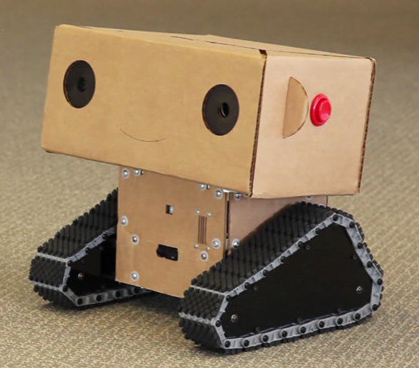The smarties at the MIT Media Lab had a problem they were trying to solve - how to create a small, mobile, low-cost, audio and video equipped, and functional robot that could travel the campus and surrounding area on its own, find and approach random people, and get them to answer questions on camera. C'mon, look how cute I am!
C'mon, look how cute I am!
Not such an easy problem to solve - since most people don't really seem to want to engage with other people that they do not know when approached on the street, what luck would the little robot, named Boxie, have with rolling up on passers by and getting them to stop, engage, participate, (and not break or steal), her. How could the designers build and enable such a robot to successfully meet this goal, while constrained in equal measures by time, cost, and complexity? When you think about it, even though this specific problem is a bit unusual, and unlikely to come up in most of our professional pursuits, the essence of the problem, how to capture attention, engagement, and assistance from audiences that are not always motivated or incented to help is much more common and universal.
So in part limited in design by practical constraints, but by also skillfully capitalizing on most people's susceptibility to anything perceived to be 'cute', the MIT team, led by Alexander Reben, created Boxie with a soft, cardboard head, (rather than the original cold white plastic prototype), a very simple set of verbal interactions, and programmed her to ask people for help, and to intentionally elicit an emotional response from the ones she engaged with. Turns out being adorable, even in cardboard robots, is a pretty powerful tool in getting what you want.
The end result was that (most) people did want to help Boxie complete her assignment, helping her when needed, (like lifting her up on a table to get a better camera angle), and taking the time to connect more deeply than is typical with most artificial, task-oriented systems.
You can see more about the project and see and hear Boxie in the video below, but I wanted to pull out a couple of key quotes from the designers that are worth considering by anyone designing tools, programs, or environments that rely on adoption by an often skeptical world to succeed.
One - "We hope that this type of interaction that we studied will lead to simpler systems that may be more symbiotic with people instead of just trying to be a cold system without much interaction."
Two - "We think we can use this simple, emotional tie to create better systems and better interactions for people."
I like this line of thinking. Even if the MIT lab had the time and money to build a more fully functional, sophisticated, and powerful robot, it seems at least possible that such a robot would not have had any more success than the small, cheap, but likely to tug at the heartstrings Boxie.
While workplace and enterprise systems can probably never be 'adorable' or even cute, perhaps we could think just a tiny bit less about what we want people to do with our systems and just a little more more about how we want them to feel when using them.
It seems to be a winning approach for a tiny cardboard robot named Boxie.
Below is the video I referenced, courtesy of the MIT Media Lab